April 22-May 7, June 11-12, July 3-16
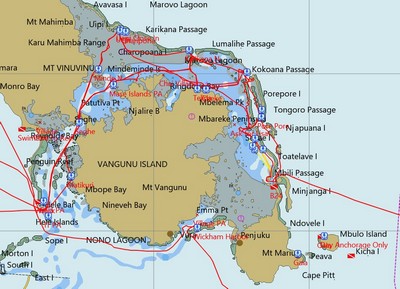
Note lack of detail on chart!
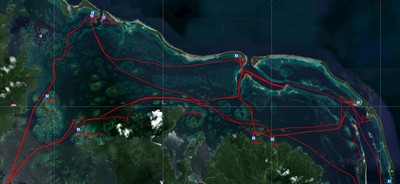
Note all the reefy areas! (Click on picture to expand)
We had been hearing about Marovo Lagoon ever since we had a "Tell us about the Solomon Islands" session with cruising friends in Palau in 2014. We were finally there, and in 3 visits during April, May, June, and July, we thoroughly explored the entire lagoon area.

On our visit April 22 to May 8, we were on a mission to get further south and east before the SE Trades started increasing--supposedly this was around May 15. So we didn't do as much exploring as we'd have liked to, but we did cover the highlights.
Our first stop was Matikuri, where we'd had a number of reports of the Matikuri Lodge and it's welcome from other cruisers. Sadly, the driving force behind Matikuri Lodge had passed away a few years earlier, and the rest of the family fumbled the ball. A few bad reports on Trip Advisor from disappointed tourists, plus new logging activity in the area, and it was barely operating. They did have 2 guests while we were there, and we managed to get them to make us dinner one night. And we hired them to take the 7 of us to snorkle the small boat tunnel to the WNW of Matikuri Lodge.
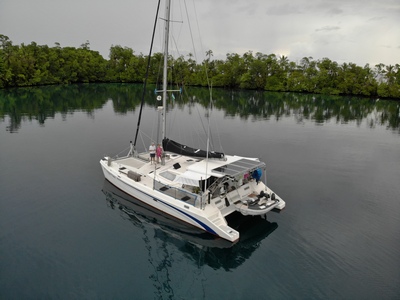
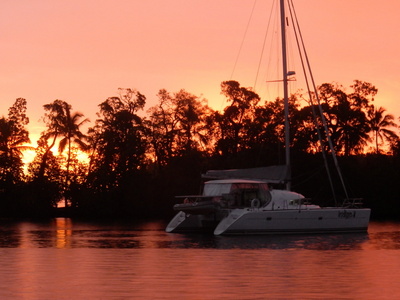
We never stopped at Matikuri again, as we found the anchorage pretty buggy (small black flies, not mozzies).
We did a day stop at Seghe, the main town (with an airport). Liz wanted to mail a letter to her mum, so we set about finding the post office. It turns out that there is not one, but we were directed to a small store at the SDA end of the village. The proprieter of that store handled the mail--either putting it on the several-times-a-week Solomon Airlines flight, or on the twice a week freight/ferry. He had no stamps but assured Liz that her letter would get stamped and mailed when it reached Honiara.
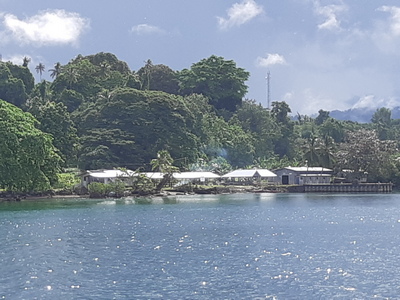
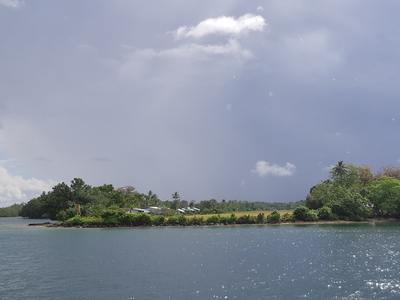
We were surprised to find pretty good cell coverage in Marovo. A few places had only a glimmer of a signal, but most places, if we got our phone up high, we had enough signal so that we could do light internet, using our phone as a hotspot. The only challenge was keeping credit on the phone. For some reason, the Solomons Islands are excluded from the countries that our online topup site would work with (Ding.com and associated Ding app). Ding has worked in Malaysia, Thailand, Cambodia, Philippines, Indonesia, and Papua New Guinea, but it doesn't work in the Solomons. That meant we had to find someone who could sell us top-up. Sometimes we had to give money to someone with our phone number written on a piece of paper, and they would hike to the next village and purchase credit for us from a tiny store that had both My Telekom credit, and signal.
And if you weren't careful and let your data package run out or expire, it would run through all your credit and you were out of business. This happened to me twice before I got smart and kept the credit on Dave's phone (he didn't do data), and only transferred it to my phone when I was ready to buy a data package.
So we bought some top-up from a store in Seghe, also gasoline, and a few veggies. The first time through Seghe, there was a nice but very small veggie market on the south side of the island, near the store where we bought a few things and some dinghy gas. The next time, when I really needed veggies (Saturday morning when my daughter was flying in for a week in Marovo), the market was not operating! Apparently the big market is Friday, and Saturday is the day off.
We stopped for a day at legendary Uepi Dive Resort on the north side of Marovo Lagoon. (Note: Uepi is pronounced several ways by people in Marovo... some say Yoo-pee, some say Wee-pee, and some say Yoo-ee-pee, we're not sure which is correct!)
This is a beautiful exclusive resort where people pay ~$300 per night for a room and $100 per dive. We didn't expect to go diving, but did hope to go in for dinner. But we didn't have a great experience there. First, as we were trying to anchor in a sand spot (avoiding the coral patches carefully), a boat came out and told us we couldn't anchor there because we were on a heavily traveled route and boats traveled through there at night. (false, it turned out). Dave asked where we should anchor, and the boat led us to a deeper corally spot, and closer to the resort! It was stupid, seemed like just harassment.
But it was Dave's birthday, so we really wanted to go in for dinner. We cleaned up and put on our best yachtie dress-up clothes and took the dinghy in to look around. The workers at the dock were friendly enough, but when we went in and tried to make a reservation for dinner, we were told they couldn't accommodate us. What about the next night? Nope. We never did get to meet/talk to the owner/manager--just an underling who couldn't make a decision on her own. The owner/manager was "unavailable". Probably some yachtie took advantage of the situation some time in the past, and screwed it up for the rest of us... That's why we (and Seven Seas Cruising Association) emphasize the need for leaving a "clean wake". One bad deed by one yachtie can screw it up for all yachties for years to come.
We did enjoy the weekly carver's display at Uepi. The resort permits all the local carvers to come one day a week to exhibit their carvings. They are strictly regulated by the resort as to negotiating tactics, etc, so as not to bother the guests. This is a great place to see all the best carvings in one spot. But because it is held at an upscale resort, the prices that the carvers are asking tend to be fairly high.
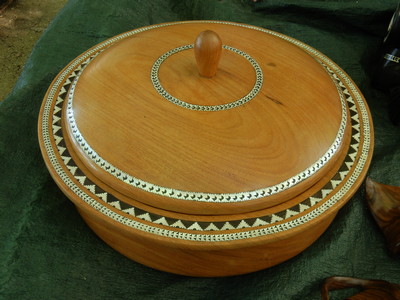
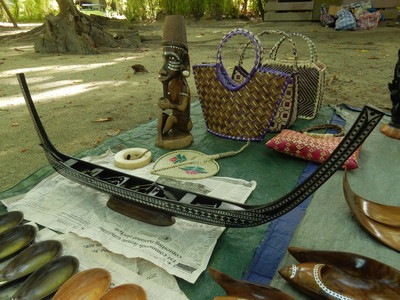

Nearly every carver had Muzu Muzu's for sale. These were traditionally mounted on the bow of the war canoe, and when the canoe was going out to collect heads, the man had a skull in his hands (this one has a bird, which signifies peace).
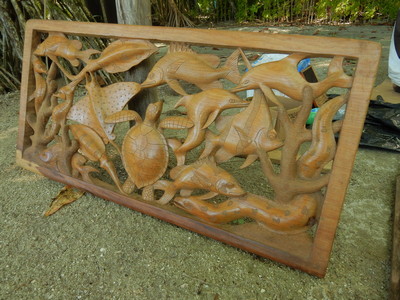
Many carvers also had "Spirit of the Solomons" carvings, depicting the many facets of Solomon Islands life. Some were carved as wall hangings and some as stand-up statues.
From Uepi, we took a break from carvers and canoes and anchored off a beach near Lumalihe Pass. We took the dinghies out for a snorkel on the outer wall. The water was very calm and clear. I would have like to stay another day and make a dive there, but Dave and our buddies wanted to press on to the next carver village.
The next stop after Lumalihe was looking for the world renowned carver called "John Wayne" in Telina Village. We're pretty sure that that's not his real name, but it is the name that all the cruisers passing through over the years have referred to him as. Supposedly he is/was the best carver in Marovo. But we were a little disappointed in what he showed us. Apparently most of his carvings are already consigned and he didn't have a lot on hand.
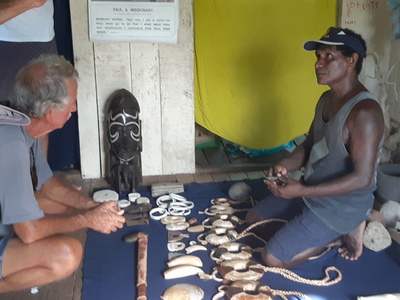
We did really enjoy meeting his nephew, Rocky, who lives on the island just offshore of Telina. Rocky is a very talented and imaginative carver. He is not happy to just keep making the same tourist pieces, but is more of an artist exploring his art. He showed us the book he was studying, with pictures and sketches and mythology from early explorers in the Solomons.
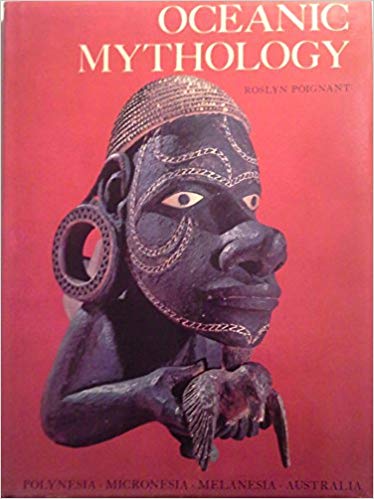
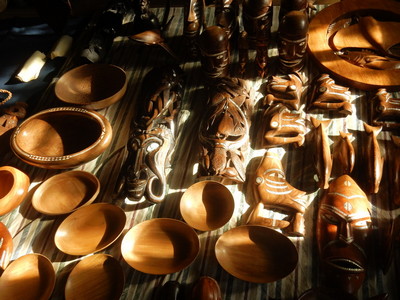
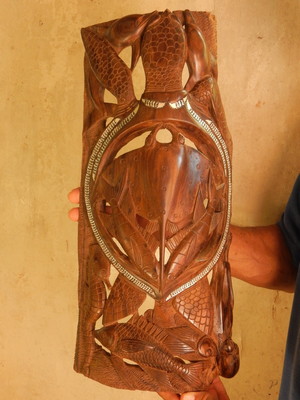
The next day we moved 2 miles east to Cheke Village. A couple of the Cheke carvers had come out to visit us in their canoes when we were anchored at Lumalihe Pass, and we had put them off then by saying "We'll come visit your village later." "Later" came quickly and as soon as we dropped our anchor, visitors came by in their canoes.
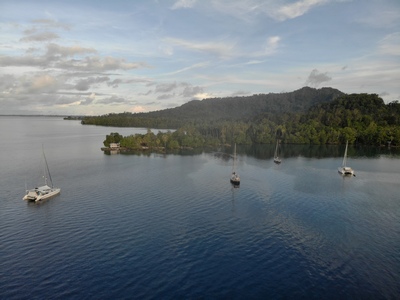
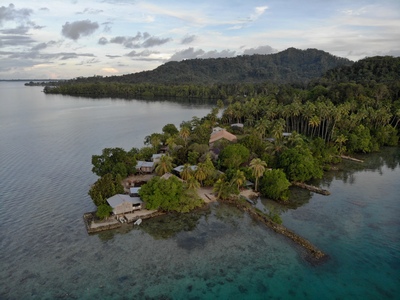
They are quiet and respectful but very canny in their dealings with visiting yachts. We had trouble saying "no" even when we had acquired way too many carvings or didn't need any more veggies. But it is exhausting having visitors stop by.
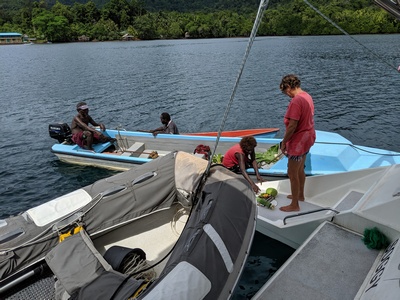
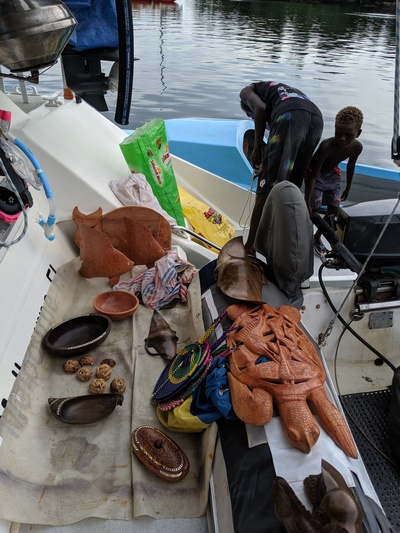

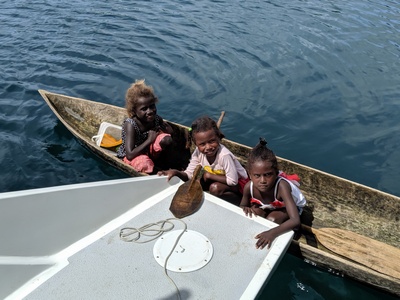
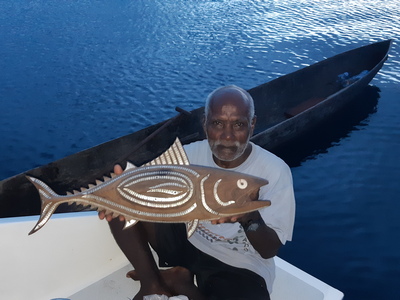
All of the villages are on the "mainland" island of Vangunu Island. There are no villages on the outer rim, though all the reefs and islands are owned by someone. The villages stay on the mainland due to a lack of water on the outer islands. But men and families in dugout canoes travel all over the lagoon under paddle power. There are a few motor boats--each village owns at least one--to go the long distance into the main town of Seghe.
So, when we wanted to take a break from all the visitors, we headed back out to the outer rim. This time we anchored on the NE side in a place called Pore Pore. We didn't have any other cruiser's tracks going in, but we did have good satellite pictures. We found a gap in the reef that was 8-10 feet going in over the reef, and then it deepens out to 20-25 ft nice sand, off a pretty beach. AND NO VILLAGE! We stayed a day there the first time and came back twice more later for several days at a time.
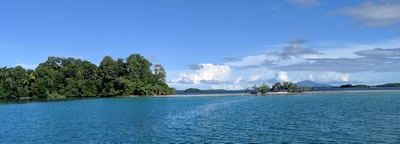
The final stop on our first pass through Marovo Lagoon was a village called Mbili. (pronounced Billy with a short mm at the beginning). The actual village is on an island just outside the main lagoon rim. But the anchorage is inside the pass, next to a small dive operation called Solomon Dive Adventures. Lisa has been running a dive operation in Marovo for a bunch of years, but has moved locations several times. She is current located on a Tambapeava Island, just inside Mbili Pass.
The first guy out to see us in a canoe was Paul, and he offered to arrange a "showing" of carvings that afternoon, so all the villagers could put out there wares at once, and we wouldn't be inundated by canoes for the next 2 days.
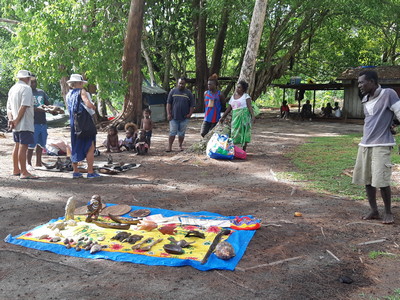
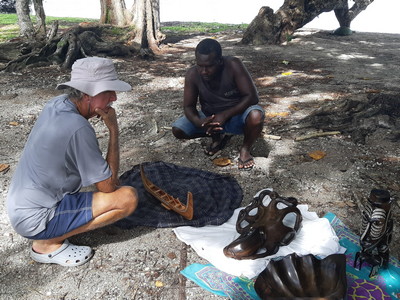
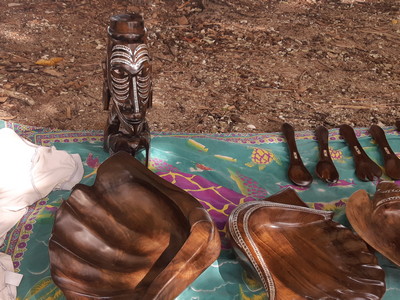
We stayed nearly a week in Mbili. It was a nice anchorage. Lisa was friendly, and even shared one of her favorite lagoon dive spots with us.
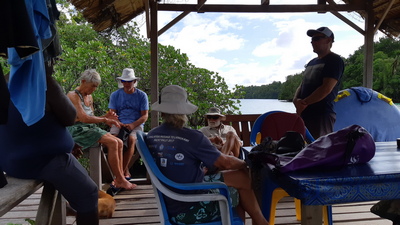
The dive is called "Pipes" it the terrain is so-so, but the "critters" were pretty cool. We encountered 2 big, friendly octopi, and a bunch of other smaller critters.
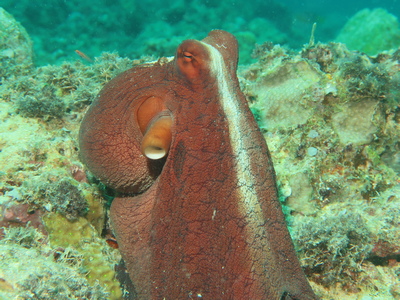
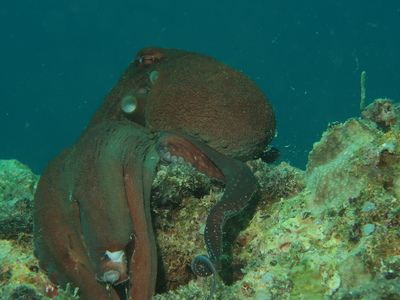
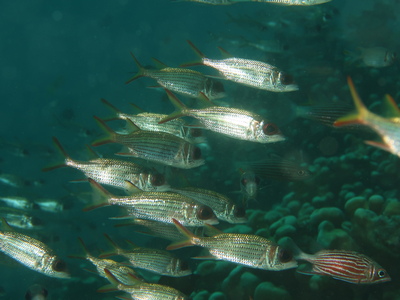
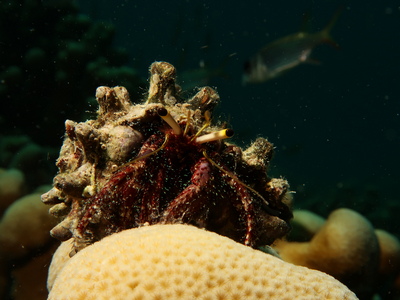
Lisa also arranged for us to take a trip up a "river" to see a family of canoe makers. The primary canoe maker moved out into an uninhabited area to be close to where the trees grow. He moved his extended family with him, and there is now a small school and several families with a lot of cute kids.
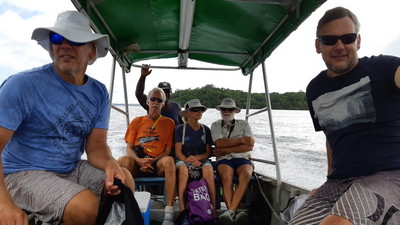
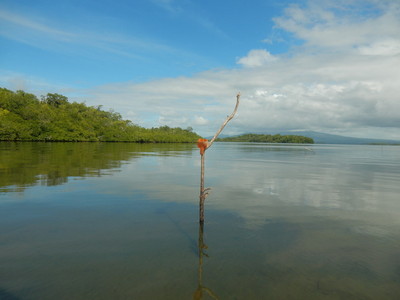
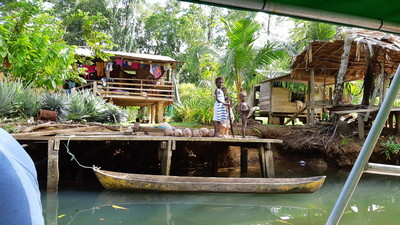
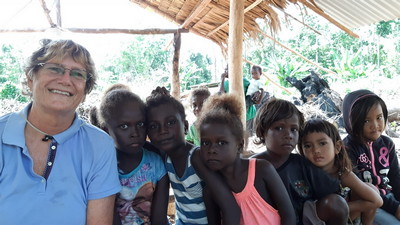
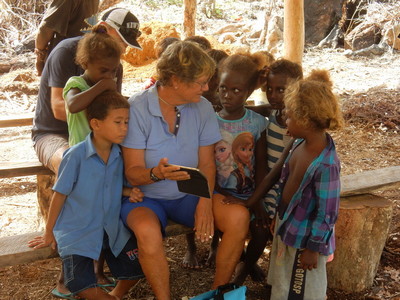
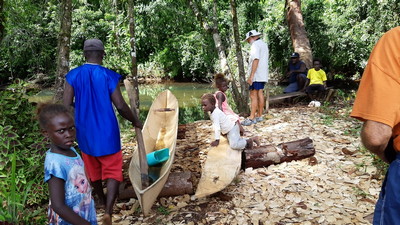
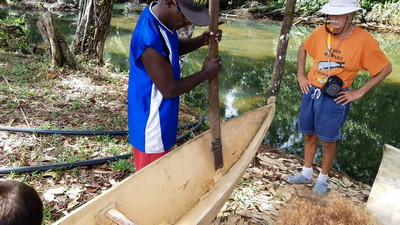
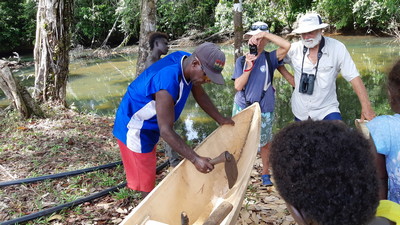
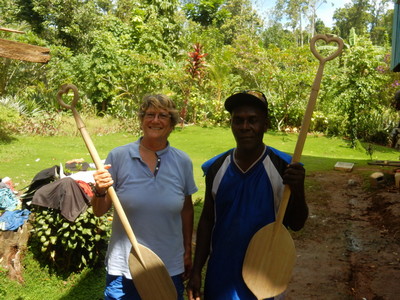
There are two weekly ferries that transit Marovo Lagoon in both directions, they leave from Honiara and go to Gizo, making several stops in the Lagoon, including a stop near Mbili, and also at Seghe. They turn around in Gizo and head right back to Honiara. It would be a cool way to see a good cross section of the Solomon Islands.
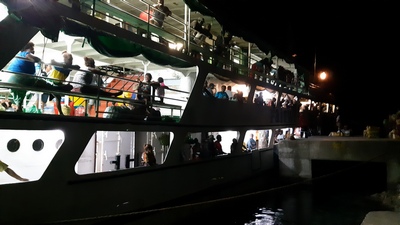
We came back to Marovo Lagoon when daughter Nicki visited. More on their visit in another post.
No comments:
Post a Comment